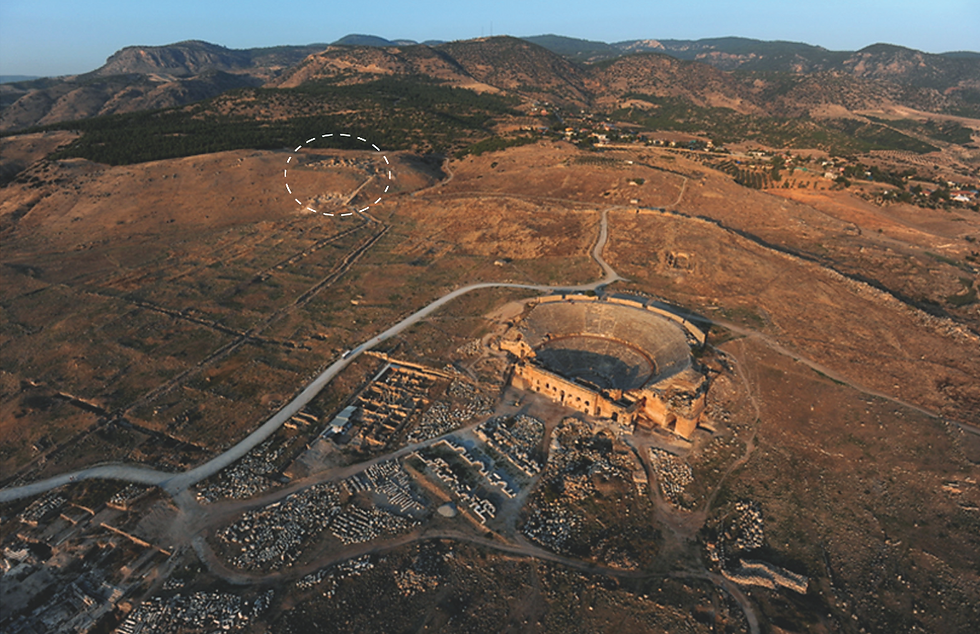Demos (the people), Boule (the city council), and Gerousia (the council of elders) can be found as personifications of municipal institutions on Imperial coins from Asia Minor. Today's coin of interest shows Gerousia, the council of elders, and explores the Hierapolis, a tourist destination today, and an archeological site where the tomb of Apostle Philip was discovered in 2011. Our modern word geriatrics was derived from the geronte, a group of men over 60 years who ran the legislative council (gerousia) of Athens.
The Role of the Gerousia in Greek Cities
A review of Katarina Martin's book describes the uncertain role of the Gerousia (relative to the Demos and the Boule).
"In the Hellenistic Age, public and cult statues of both personified (Demos and Boule) institutions reveal a well established iconography before the imperial age. In contrast, depictions of Gerousia (who appears far less frequently) dates for the Roman imperial age, and these are almost exclusively found on coins. The numismatic record is clear. The three personifications are overwhelming depicted on coins minted in the province of Asia. Many of these cities, located in Lydia, Phrygia, and Caria, proclaimed Macedonian or Greek origin. The municipal authorities commissioning these coins consciously employed well established visual and epigraphic conventions to present their cities as a polis, which Aristotle would qualify as a Hellenic community with a constitution that followed the rule of law. The proliferation of these coin types date from the Antonine Age. These coin types are but one of several indices of the rising sense of civic consciousness at least among the notables who dominated these institutions and commissioned the coins.
sehepunkte 15 (2015), Nr. 6 Katharina Martin: Demos - Boule - GerousiaThe depiction of Gerousia is a young male similar to the personification of Demos. Here is a Phrygian coin showing the personified "Demos", the ruling body of free citizens in ancient Greek city-states personified. In this case the citizens of Cotiaeum, Conventus of Synnada reading "EPI ΑΥΡ ΜΑΡΚΙΑΝΟΥ ΚΟΤΙΑΕΩΝ", Cotiaeum in the time of Aurelian Markianos magistrate (archon). One of only 4 known examples, 3 found in Roman Provincial Coins. Cybele seated between two lions, facing left, on the reverse is holding a patera and resting her arm on tympanum. This pseudo-autonomous coin is from the time of Elagabalus (AD 218-222).

"The personification of Gerousia, as yet, has no precedents in the Classical or Hellenistic visual arts. Coins bearing portraits of Gerousia date from the Flavian Age, and the obverse portraits show the even more variation that those of Boule (Martin, 141-151). On coins of Antiochia ad Maeandrum and Aphrodisias, a youthful male Gerousia, similar to Demos, was featured on some coins. The personification likely represented different institutions at different cities. At Ephesos, the Antonine benefactor C. Vibius Saltutaris notes in his endowment that he dedicated a silver statue to sacred Gerousia by which he meant the boule of the city (Martin, Demos 4, 257-259). The boule might also been intended when M. Ulpius of Eurykles struck medallion sized bronze coins featuring the Disocuri (almost certainly a statue group donated by Eurykles) on the reverse with a dedicatory inscription to the Gerousia of Aizanoi (Martin, Aizanoi 6-7).
- sehepunkte 15 (2015), Nr. 6 Katharina Martin: Demos - Boule - GerousiaAn 1890 publication by D.G. Hogarth in the Journal of Philology, documents the epigraphic references to the Gerousia of Hierapolis and the responsibilities that seem hold responsibilities for burial rites and maintenance of places of burial.
"In Hierapolis however we hear more of it as Trustee of special bequests for the semi-religious purpose of adornment, or maintenance, of places of burial: Menadier holds that such bequests “non publice gerusiae tradita erant sed privato contractu ab unoquoque ei mandabantur” (p. 59), for many other bodies or groups of individuals were left in charge of similar trusts. The following inscription however, which was copied by us from a sarcophagus in the Sacra Via, shows that there was at any rate a regular organisation for the reception, and recording of such trusts, and that the highest executive officials of the Gerousia sometimes administered them."
Hogarth, D. G.: The Gerousia of Hierapolis, Journal of Philology, vol. 19, 1890, 96/Nr. 20.Including this inscription from a sarcophagus:
Source: THE GEROUSIA OF HIERAPOLIS, Hogarth, D G. The Journal of Philology; London Vol. 19, Iss. 38, (Jan 1, 1890): 69.
This Type in Catalogs
The British Museum, in Vincent Barclay Head's 1906 catalog of coins from Phrygia, documents my coin of interest as #79 for Hierapolis.
Leo Weber also references this coin in his 1913 listing of on "The Coins of Hierapolis in Phrygia" in the Numismatic Chronicle.
Weber, Leo. “THE COINS OF HIERAPOLIS IN PHRYGIA (Continued).” The Numismatic Chronicle and Journal of the Royal Numismatic Society, vol. 13, 1913, pp. 133–61.
A Coin of the City Council
This coin shows Boule (the city council) voting.

Syria, Seleucis and Pieria, city of Antioch a Pseudo-autonomous issue. Assarion (Bronze, 19 mm, 5.89g, 1h), CY 115 = 66/7 AD.
Obv: ΑΝΤΙ[ΟΧЄΩ]Ν Diademed head of Zeus to right
Rev: ЄTO - ЄIP Boule seated left, placing vote in urn
Ref: RPC I 4305. McAlee 112; Butcher Coinage in Roman Syria 141
Here's another depiction of Boule from Caria:

Roman Provincial Coins, Caria, Trapezopolis, pseudo-autonomous (Mid-late 2nd century) AE (18mm, 3.57g)
Obv: ΙЄΡΑ ΒΟΥΛΗ, veiled and draped bust of the Boule right.
Rev: ΤΡΑΠЄΖΟΠΟΛΙTΩN, Asklepios standing facing, head left, leaning on serpent-entwined staff
Ref: BMC 4
Greek Imperials
An article by Tom Jones in 1963 documented a peak in "Greek Imperial" coins (today called Roman Provincial) around the time of Septimius Severus.
Jones, Tom B. “A Numismatic Riddle: The So-Called Greek Imperials.” Proceedings of the American Philosophical Society, vol. 107, no. 4, 1963, pp. 308–47.
Another Coin with Gerousia
This coin (not mine) showing Gerousia from Hieropolis can be found in the Boston Museum of Fine Arts.
Finally: my coin of interest

Roman Provincial Coins, Phrygia, Hierapolis, pseudo-autonomous (2nd-3rd centuries). AE (6.87g, 23mm)
Obv: ΓЄΡΟVСΙΑ, laureate, veiled and draped bust of Gerousia right
Rev: ΙЄΡΑΠΟΛЄΙΤΩΝ. Apollo-Tyrimnaios on horse trotting right, holding upright double axe (bipennis)
Ref: RPC IV online 9789; SNG Copenhagen 434; BMC 79-81.
Apollo-Tyrimnaios is identified by the bipennis, a double-edged axe, that he wields. Coins with similar reverse are found from other cities in Asia Minor. Some examples can be seen with this search in RPC.
Hierapolis and Apostle Philip
Hierapolis, today Pamukkale, Türkiye shown on Google Maps.
Hierapolis was a wealthy in the fertile Lycos river valley region of Phrygia.
The site of Hierapolis sits, almost majestically, on a limestone platform at some 350 metres above sea level, on the western edge of the Anatolian plateau, and overlooking the eminently fertile Lykos river valley, in western Asia Minor. In extent, its ruins cover almost 800,000 m 2 and it is clear that they must always have formed a prominent landmark. he visibility of plan, public and private space, and sprawl, is remarkable, and given the limited post- medieval and modern settlement around the former polis, robbing has been restricted principally to movement of stone around the site. In total, over 50 years of archaeological investigation have taken place at Hierapolis which have helped reveal the city’s growth, monuments and population.
- Arthur, Paul(2012). "Hierapolis of Phrygia: The Drawn-out Demise of an Anatolian City", Vrbes Extinctae, Archaeologies of Abandoned Classical Towns, N. Christie, A. Augenti (eds,), Ashgate.Antiochus III "The Great" ( reigned 228–187 BC), relocated 2000 Jews to Phrygia and Lydia to secure his control over the region. The relocated people were granted privileges of self-governance, land for homes and to farm, and freedom from taxes taxes on agricultural products for ten years.
“Having been informed that a sedition is arisen in Lydia and Phrygia, I thought that matter required great care. And upon advising with my friends what was fit to be done, it hath been thought proper to remove two thousand families of Jews, with their effects, out of Mesopotamia and Babylon, unto the castles and places that lie most convenient. For I am persuaded that they will be well disposed guardians of our possessions; because of their piety towards God; and because I know that my predecessors have born witness to them, that they are faithful, and with alacrity do what they are desired to do."
-Josephus, Antiquities of he Jews, XXI.3These Jewish settlements thrived and centuries later contributed to the spread of Christianity. It was likely that the Apostle Paul chose to go to this region because of the sizable Jewish population. Roman tax documents from 62-61 BC, count 45000 male Jewish citizens in Anatolia.
The modern city of Pamukkale, located on the site of ancient Hierapolis. Pamukkale means “cotton palace,” so called for it's cliffside hot springs which have been used as spas since the city was founded by Antiochus III. The springs are a tourist destination today along with Greco-Roman ruins.

Ancient Hieropolis, modern Pamukkale, thermal pools and limestone terraces. Image from pixabay.com used under the terms of pixabay's content license.
In 2011, and Italian archeologist, Francesco D'Andria, identified the tomb of Apostle Philip near Hierapolis. Traditionally Philip was martyred, crucified up side down, in Hierapolis during the reign of Domitian (81-96 AD). Philip and Bartholomew were preaching in Hierapolis and local officials had them crucified. Bartholomew survived when an earthquake scared the people of Hierapolis into ending their crucifixions, however Philip died.
Hierapolis. Aerial photograph with the hill of St Philip (in circle) and the Roman theatre in the middle (photo A. Gandolfi; The Sanctuary of St Philip in Hierapolis and the tombs of saints in Anatolian cities, in J.R. BRANDT, E. HAGELBERG, G. BIØRNSTAD, S. AHRENS, Lıfe and Death in Asia Minor in Hellenistic, Roman and Byzantine Times. Studies in Archaeology and Bioarchaeology, Oxford and Philadelphia, 2016).
Here's one last coin for this thread - a pseudo-autonomous Lydian coin with the personified Senate or Synkletos:

Lydia, Apollonis Æ 16mm. Pseudo-autonomous issue, circa 1st century AD.
Obv: AΠOΛΛΩNIΔЄΩN, draped bust of Apollo to right
Rev: IEPA CVNKΛHTOC, draped bust of the Senate to right.
Ref: GRPC Lydia 13; RPC II Supp. 952A











Comments